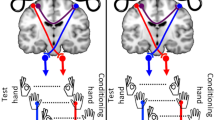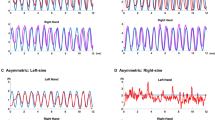Abstract.
In vivo magnetic resonance imaging has revealed that the anterior half of the corpus callosum is larger in musicians trained intensively from an early age than in untrained subjects. The corpus callosum is crucial for the coordination of bimanual motor activity, but neurophysiological correlates of morphological differences in the corpus callosum of musicians are not known. In the present study we have used transcranial magnetic stimulation (TMS) to assess interhemispheric inhibition in six adult professional musicians who began musical training at an early age. Conditioning TMS was applied to the hand area of the motor cortex of one hemisphere, followed 4–16 ms later by a test stimulus applied to the other hemisphere. Tests were performed at rest, and with the first dorsal interosseous muscle contralateral to the conditioning hemisphere voluntarily active. Conditioning TMS in musicians was 29% less effective at reducing the size of the test MEP at rest, and 63% less effective in the active condition, compared with control subjects. We conclude that transcallosal interhemispheric inhibitory circuits activated by TMS are less effective in musicians than in controls.
Similar content being viewed by others
Author information
Authors and Affiliations
Additional information
Electronic Publication
Rights and permissions
About this article
Cite this article
Ridding, M., Brouwer, B. & Nordstrom, M. Reduced interhemispheric inhibition in musicians. Exp Brain Res 133, 249–253 (2000). https://doi.org/10.1007/s002210000428
Received:
Accepted:
Issue Date:
DOI: https://doi.org/10.1007/s002210000428




